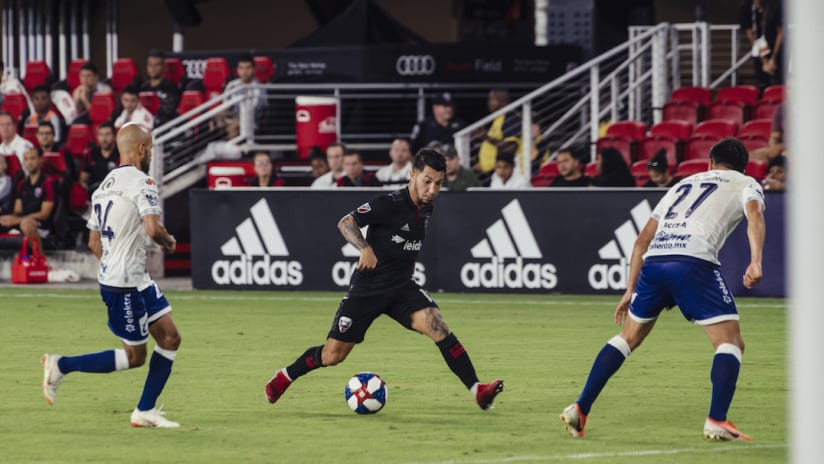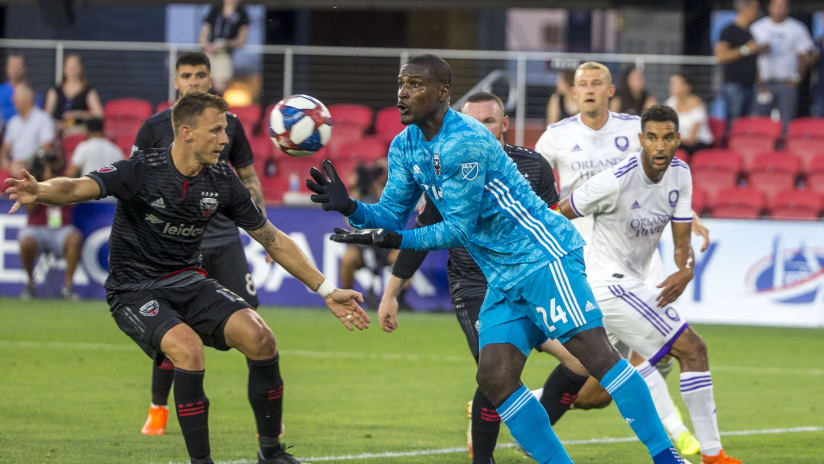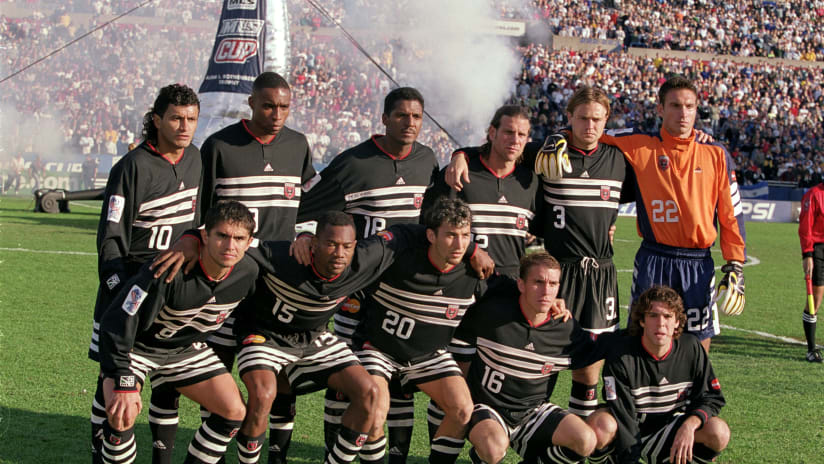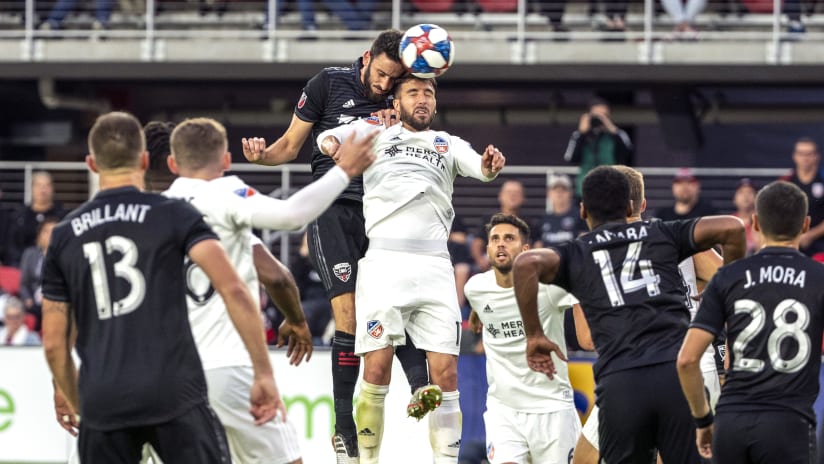The winding trek from the home locker room to the crow’s nest at Audi Field begins at 7:04 p.m., roughly an hour before D.C. United kicks off against Club Puebla on Sept. 4 in its final friendly match of the season.
With a coffee in one hand and a protein bar clenched between his teeth, data analyst intern Sam Goldberg hauls a black and red roller bag up two flights of stairs, around the southeast corner of the field, through the team bench area, beyond a set of glass doors and into an elevator for a ride to the top of the stadium, toward the nexus of sections 106 and 107, where a pair of folding tables and red chairs offer a workspace with a sprawling, centralized view of the pitch.
His journey lasts seven minutes and, on an evening when temperatures climb past 90 degrees, a considerable amount of sweat. “It’s not even that bad,” Goldberg says with a smile, the memories of even hotter nights still fresh in his mind.
He will be joined shortly by Sam Marich, a performance analyst specializing in video work, and their boss, technical director Stewart Mairs who serves as the chief lieutenant for general manager Dave Kasper after earning a promotion earlier this year. Buried behind four computer screens and one video camera they form an invisible trio with an indispensable set of matchday responsibilities: They are the electronic eyes in the sky for the coaching and technical staffs at field level, communicating directly to the sideline via headset while simultaneously transmitting data and video to iPads on the bench for on-the-fly, in-game use. The more information they provide — and the faster they can provide it — the more informed certain tactical decisions can be.
In other words, they are scouting the match in real time.
“It’s nice to use it as a way to either confirm what you’re seeing or to show us something that maybe you didn’t identify as a trend,” said assistant coach Nolan Sheldon, who communicates directly with the crow’s nest and clutches an iPad on the sideline. “What we’ve found is that the more structured the game, the better the information is.”
*
The headset crackles to life nine minutes before kickoff as Sheldon settles into his seat on the bench, nestled between head coach Ben Olsen and director of goalkeeping Zach Thornton. “Hey-hey, coach,” Marich says from the crow’s nest to test their connection.
There is far less pressure surrounding a friendly match than a regular season game where points and playoff positioning are crucial, so the mood among Marich and his colleagues is understandably light. They rejoice when Goldberg succeeds in yanking an ethernet cable through a small opening to avoid an extra trip downstairs for additional tools. They debate the best-tasting energy drinks and swap stories about players with unusual methods of caffeine intake. And once Mairs arrives, they riff about Emiliano Garcia Escudero, the 15-year-old striker on Puebla’s bench, a player about whom Mairs received a text from an agent in Argentina earlier in the week.
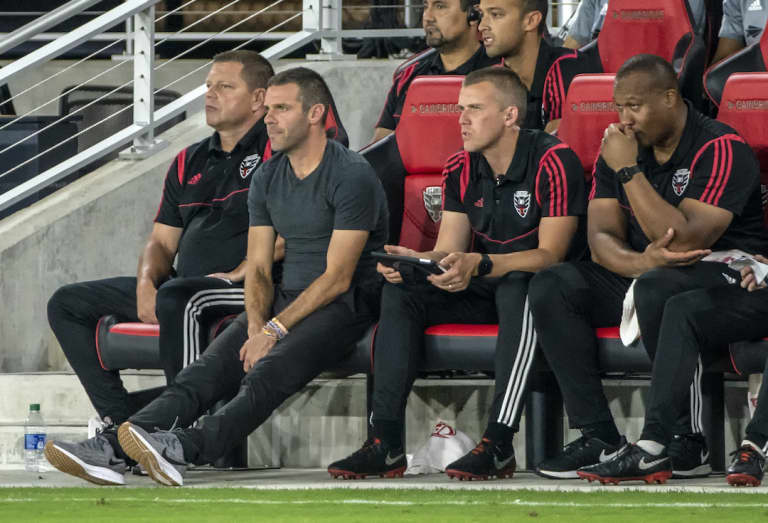
“I’m looking more at the Puebla guys,” Mairs said of his focus for the evening.
In the middle of the trio is Marich, a 23-year-old graduate of the University of Colorado Boulder with a bachelor’s degree in business administration. By his junior year of college, Marich knew he wanted to pursue a career in soccer and focused his studies on leadership management to acquire what he believed were applicable skills in the absence of a sport-specific program. He doubled down by finding extra work to fund his entrance into an online soccer analytics course, offered through Sports Management Worldwide, and developed positive relationships with two of the program’s mentors: Lee Fraser, the head of talent ID analysis at Newcastle United, and Matt Martin, the director of scouting and co-founder of Soccer Syndicate, a North American scouting network.
Among other things, the class familiarized Marich with Wyscout, an Italian company whose scouting database is utilized by clubs, analysts and journalists across the world. It’s a fascinating resource with player profiles from nearly every league imaginable, and each profile includes biographical information, statistical breakdowns, pie charts, tendency graphs and more. Video clips for each player are broken down into easily accessible categories like fouls, passes, movements and shots — all available in an instant.
“The class was definitely worth it,” says Marich, who paid $1,450 in tuition and uses Wyscout frequently in his role with United.
Toward the end of high school, Marich secured an internship with D.C. United’s academy and then another with the equipment staff for United’s first team. He later applied his knowledge of Wyscout to write one-page scouting reports for Mairs about various players the team was monitoring. And then, several years after Marich’s connection with the club was forged, Mairs hired him as a full-time performance analyst earlier this year.
On game days, Marich lives in the video realm. His laptop connects directly to a camera filming the action from a wide-angle point of view, a vantage point that includes 21 of the 22 players on the field. (The goalkeeper on the opposite end is the lone exception.) With his right hand, Marich operates the camera by following the game from side to side, much like watching a tennis match. And with his left hand, Marich prepares video clips or still shots that are quickly transferred to the iPads via Dropbox.
“It was f** scary at first,” Marich says. “For me the focus is staying calm.”
As the Puebla match begins, Marich quickly designs what looks like a PowerPoint slide of the opposition’s formation superimposed onto a graphic of a soccer field. Goldberg calls out the numbers and positions as Marich plots them on the computer screen, a process unique to this particular game because Puebla is an uncommon opponent, meaning advanced scouting was minimal. Once finished, the file is sent to Sheldon down below.
The material Marich sends to Sheldon is a mixture of general match details and personalized requests from the coaching staff. He separates footage into categories like structure, chances and goals to make things easily accessible on the iPads for in-game adjustments and post-match review. There are also times when Marich receives a specific instruction based on something that happens during the game — an impressive buildup by the opposition or a choreographed set piece, for instance — and the corresponding footage is gathered, tagged and transferred immediately. In fact, Marich says he created a specific tag for “Nolan Sheldon” after beginning to understand the types of things the coach prefers, and at halftime he cues some of those plays on the television screen inside United’s locker room after scampering to field level.
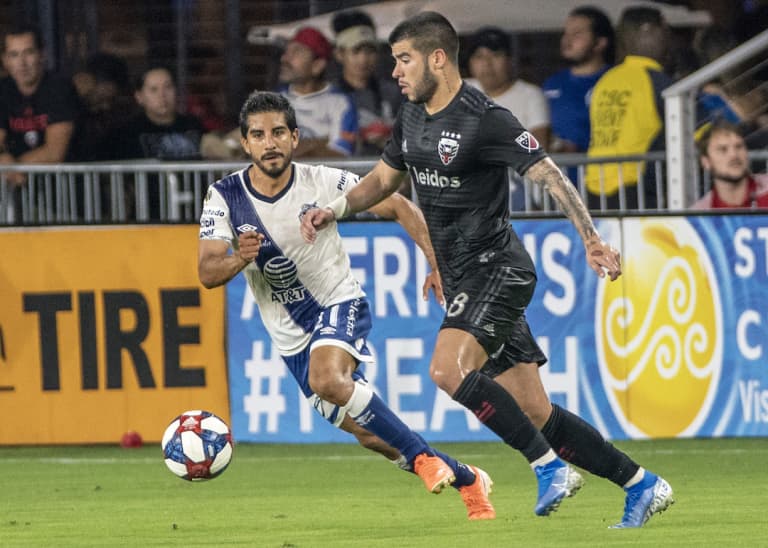
“Video of the goal and screenshot of Puebla’s general structure coming down now,” Marich says a few minutes into the match. Striker Quincy Amarikwa has just given United an early lead.
*
What Marich offers the staff in visual form is supplemented by numerical insight from Goldberg, whose role focuses heavily on data collection and advanced metrics. Goldberg is a 22-year-old former professional baseball player who majored in political science and minored in data science at Macalester College. He sits to the right of Marich on this steamy Wednesday evening with two computer screens under his control, absorbing the match through a statistical lens.
His first computer, a Macbook, connects to a data service for which United maintains a subscription. The service tracks every on-the-ball event during Major League Soccer matches and makes that information available in real time.
To utilize that data, Goldberg teamed with former United intern Matthew Schnell to apply a concept Goldberg had seen during a presentation linking data with basketball. Together he and Schnell, who also had a background in computer science, coded a series of algorithms designed to ingest the MLS data and produce graphics focusing on aspects of the game United’s coaches view as crucial — namely the relationship between players on the field and areas of pressure.
“I love it,” Goldberg said. “This is a dream to be doing it. This is like trying to write Moneyball for soccer.”
With the general algorithms complete, Goldberg met with Mairs to finetune the coding in a manner that aligned with United’s preferred style of play. Now Goldberg sends a new batch of data and graphics to Sheldon’s iPad every 15 minutes during matches, both home and away.
“What’s been quite good is we’re able to use their pass maps with our press to see if it lines up with whether we’re giving (an opponent) the space we actually want to give them,” Sheldon said. “So if there’s a frequency for them of who’s receiving the ball, who the ball is actually traveling through, receiving and distributing, if it’s in the areas that we want, then it’s a good indicator that confirms you’re doing what you wanted to do pretty well.”
Goldberg’s second laptop, a Dell, focuses entirely on player performance. Using a program called OpenField, which describes itself as a “cloud-based sports analytics software,” Goldberg can access the data from GPS units worn by players on the black bralettes beneath their jerseys. The units measure things like distance covered, overall workload and volume of high-speed running for each individual on the pitch.
This information is scrutinized by Jonny Northeast, the team’s head of sports science and fitness who joins the coaching staff on the bench during games. By monitoring the GPS units in practice and studying data from prior matches, Northeast has developed baseline measurements for each of United’s players. He understands, for instance, how much ground Wayne Rooney typically covers or how much energy Paul Arriola exerts during a normal shift. He can recognize when those patterns abruptly change or if someone is in the “red zone” and risks overexerting themselves, which can lead to injuries.
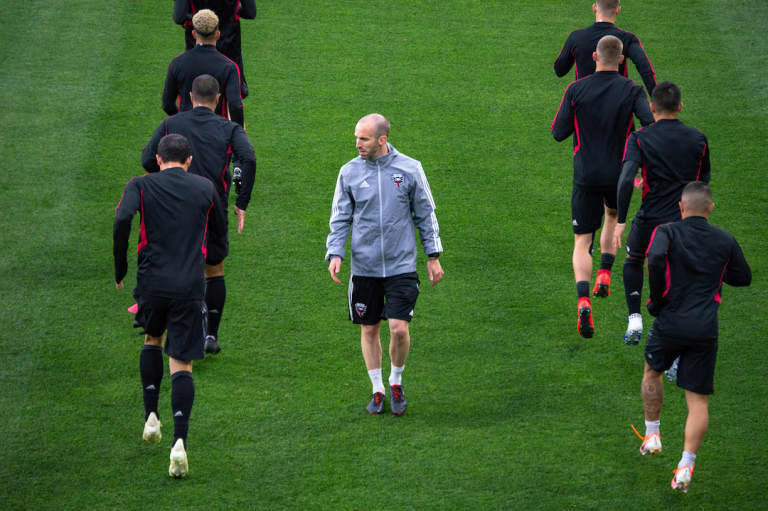
“It gives good insight to the coaches to make a tactical decision in terms of workload, who’s pulling their weight and who’s not pulling their weight,” Northeast said. “If someone’s performance has dipped within the last five minutes, we can tell the coaches and they can make an intelligent decision on their workload dropping.
“You can see each five-minute window and see if their workload is dropping. Naturally it’s going to drop as the game goes on, but if it’s dropping more than what we expected, it could be a fatigue issue, it could be an injury or it could be the fact that they’re not pulling their weight.”
*
Rain begins to drench Audi Field in the 74th minute with United clinging to a 1-0 lead over Puebla. As fans scurry toward the exits, Marich drapes a windbreaker over his computer to continue tagging and sending video while Goldberg, whose workload is significantly lighter during a non-MLS match, slides his laptops into their cases to save them for another night. Mairs, who spent much of the second half watching academy footage to maximize his time, does the same.
Puebla ties the game a minute later on a volley by forward Diego Abella, who pounced on a loose ball inside the box. And when Rooney pings a free kick off the crossbar in stoppage time — the culmination of a 90-minute shift to push his fitness levels — the match ends in a spirited 1-1 draw.
“I thought we set a really good tone about the game,” Olsen says in his post-match news conference. “I thought the first half was really good. Second half you make a few subs and some fatigue sets in on some of the players that haven’t gotten a lot of minutes so far, and you can see a little bit of the quality drain out of the game. But from a coaching standpoint of what you would want out of a friendly, this was exactly what we want.”
With the game complete, the invisible trio decamps from the crow’s nest and wades through the crowd to reach the locker room, where Northeast has already begun perusing the GPS data. As players shower and coaches grab a bite to eat, Marich and Goldberg embark on their final task of the evening: transferring game footage and data to the coaching staff’s computers ahead of the team’s next film session.
Just as soccer front offices undergo their analytics renaissance — with Liverpool of the English Premier League arguably at the forefront — coaches are experimenting with the use of sideline technology during games. Olsen and his assistants are still searching for the most relevant statistics, the most helpful video clips and the most insightful information that can be applied in the heat of the moment, when dozens of other factors are also being considered. They lean on Marich and Goldberg to tailor the possibilities accordingly.
“We’re still trying to figure it out, to be honest,” Sheldon said.
The only restriction United received from the league, according to Marich, was a mandate prohibiting coaches and staffers from confronting fourth officials with iPads during games, a reasonable request to avoid transforming the sideline into a circus, especially as VAR continues to be implemented.
Aside from that, though, the invisible trio will do whatever it can to give United an edge during matches, marrying data and video with everything in between. Their hope is that real-time scouting can produce real-time results.
“What we produce is the same thing but in different forms,” Goldberg says. “That allows the coaches to make informed decisions.”

